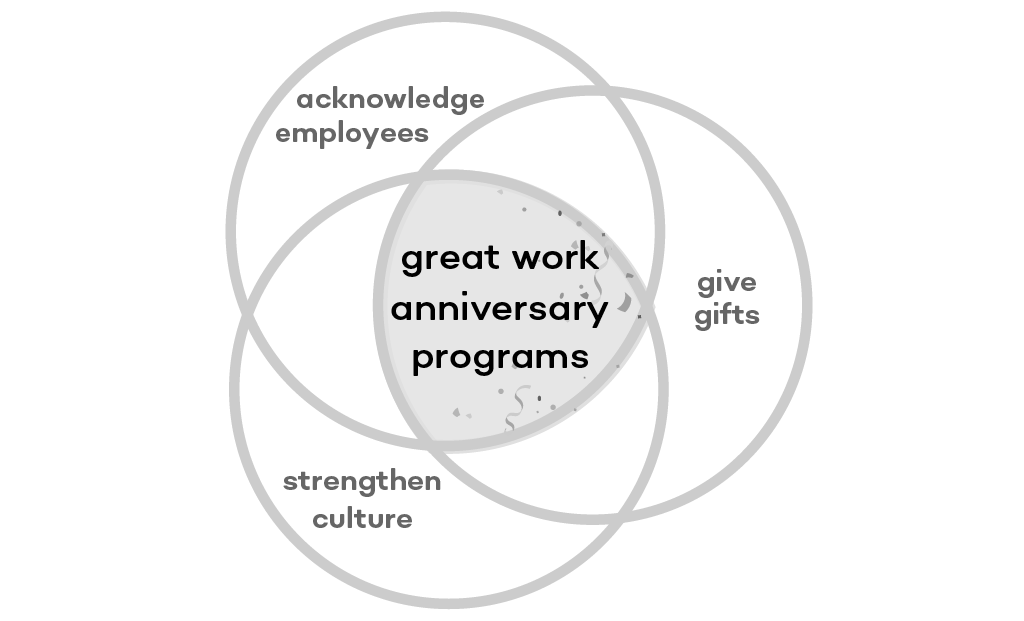Improving your work anniversary program

|
by Rick Joi Rick Joi is the founder of The Workiversary Group and author of the award‑winning book, Inspiring Work Anniversaries. |
Are you in HR and ready to improve your organization’s work anniversary program?
Then, this is the big question:
How do I get started?
Luckily, it’s actually fairly simple. There are three concrete components of celebrating a work anniversary:
acknowledging employees
giving gifts to employees
strengthening the organization’s culture
If you want to improve your work anniversary program, it’s just a matter of examining each of these three areas and deciding if you want to do something more or something different from what you’re currently doing.
This blog post will look at work anniversaries through this lens and point you to other posts in this blog related to each of these three components.
Acknowledging
Human resources can send an automated email on the day of the work anniversary, and they can publish work anniversaries in the newsletter or on the intranet, but the best acknowledgment comes from people in the management chain above the employee.
The absolute most important acknowledgment is from the employee’s direct manager or supervisor. The first step is for them to know about work anniversaries, which is covered in the subsection Remind managers in the communicating work anniversary dates within your organization blog post. For ideas on how they can acknowledge employees well, see the work anniversary tips for managers blog post.
Then consider what your organization will expect from managers and provide training to ensure everyone’s working from the same playbook. Whatever you do, make sure you expect managers to write up and share an appreciative paragraph about the employee’s past year as described in the work anniversary paragraph of appreciation blog post.
After the initial training, embed material related to work anniversaries in your new-manager training.
Acknowledgment from the CEO or other senior leaders is also impactful. For hints on doing this well, check out either the CEOs and work anniversaries or the executive assistants and work anniversaries blog posts.
And last but not least, acknowledgment from colleagues is highly valuable as well. To do this reliably at scale, you need to set up an environment where employees are aware of each other’s work anniversaries. For help with this, review the communicating work anniversary dates within your organization blog post.
Giving
The simplest rule of meaningful work anniversary gift-giving is:
Don’t give something anyone could get at any other organization
For ideas on what your organization can give, see the official work anniversary gift giving guide and for recommendations on specific vendors, check out the work anniversary vendor guide.
An especially valuable approach is empowering employees to choose what they need to be more productive at work, which has its own dedicated blog post: the greatest work anniversary gift of them all.
And for ideas about small gifts that can come personally from the manager, check out the two blog posts about capturing employee preferences: work anniversary zero (for HR) and the power of preference preparation (for managers). For tips on the manager delivering the gift, see the how managers can eliminate the #1 work anniversary complaint blog post.
Strengthening culture
The simplest, most valuable thing you can do to use work anniversaries to strengthen your organization’s culture is to make sure your organization has a clear, well-communicated purpose, then reference that purpose every time a work anniversary is acknowledged in any way — by a manager, by the CEO in the all-hands meeting, in the newsletter, on Slack, wherever. For more on the value of communicating your organization’s purpose, check out the purpose and work anniversaries blog post.
Some other elements of workplace culture that work anniversaries specifically impact are covered in the belonging and work anniversaries and perceived organizational support and work anniversaries blog posts.
Then, to learn more about the role of work anniversaries in workplace culture more broadly, check out the what are work anniversaries really? and strengthening workplace culture through uniqueness blog posts.
The power of the intersections
Finally, while it’s helpful to view a work anniversary program as being made up of three components, the best programs consciously make sure that the three components all overlap.
This diagram shows the intersections of the three components:
Looking at the intersections reveals that the best gifts are: (1) unique reflections of the organization’s culture; (2) given together with acknowledgment of the employee’s contributions over the past year; and (3) presented with a personalized message of recognition from the employee’s manager.
It’s best to avoid gifts that are: (1) random gifts the employee can get anywhere; (2) just dropped off on an employee’s desk when they’re not there; or (3) shipped by a work anniversary vendor without a personalized message from anyone.
The work anniversary program checklist ✔
As you consider improving your work anniversary program, it’s helpful to think about these three components:
Acknowledging – Remind managers about their direct reports’ work anniversaries ahead of time and on the day, encourage your CEO and other senior leaders to embrace work anniversaries as communication opportunities, and make sure work anniversary dates are broadly communicated
Giving – Don’t give something anyone could get at any organization—instead, use this book to review the many options and choose what makes most sense for your organization
Strengthening culture – Tying the organization’s purpose to work anniversaries is the most important part of using work anniversaries to strengthen your organization’s culture, but if you want to go deeper, this book includes many more suggestions
To create a new work anniversary program or improve an existing one, simply decide what you want to do in each of those three areas, but remember that none of the three components stands alone. For a truly standout program, look closely at where the components intersect.
Looking for a gift idea?
Maximize meaningfulness —while minimizing cost and effort.



